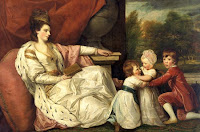When I was a kid, I loved fairy tales! I liked the fluffy, Disney-fied ones (great clothes! I mean, who doesn’t like Cinderella’s blue dress?), but my favorites were from a book of Grimm’s Fairy Tales my grandmother gave me. The ones where the stepsisters chopped off bits of their feet to fit into Cinderella’s slipper, stuff like that. Dark and fantastical, with lots of tangled forests and crumbling castles. And curses, of course. I love curses. I also liked stories from the ballet, where the heroine was usually a ghost or a part-time bird, and there were curses galore, as well as dark wizards and sacrificing for love. They had great clothes, too. But I always liked the dangerous romance of all that more than the bland princes and singing mice of the Disney version. Yeah, I was a weird kid. Probably a weird adult, too, since I still eat up all that stuff with a spoon!
As I get older and read more and more bios of real-life historic couples, I find few (if any) Disney HEAs. If there was an HE at all, it was usually twisting and halting, full of surprises and compromise. Like life itself, I guess, with fewer talking animals and dark omens than in fairy tales. But I often find the darker, more complex the “romance” the greater the story.
There are so many interesting Regency-era couples, but I chose only two to talk about. No Disney wedding endings here, of course! We’re going to look at Lady Caroline Lamb and Lord Byron (a Mess if there ever was one, but I find that whole “Crazy Love” thing fascinating, not having felt anything at all like it since high school. Thankfully). And Charles James Fox and Elizabeth Armistead, because theirs was a twisted path indeed, ending in a deep devotion.
Lady Caroline Ponsonby Lamb was the wife of William Lamb (the younger son of Byron’s friend Lady Melbourne, another fascinating character), the daughter of Harriet Bessborough (Georgiana’s sister–huh, whaddya know, more fascinating characters!), and full of all the creativity and instability (to say the least) her genes would suggest. When she met Byron in 1812, she was 27, with a few wild affairs to her name already. Byron was 24, famous as the melancholy, handsome author of Childe Harold. She read the poem before meeting him, and wrote him an anonymous fan letter, saying “You deserve to be and you shall be happy…” A few days later she set out to meet him at a party at Lady Westmoreland’s, but ran off when she saw him surrounded by other adoring women.
This, of course was the best thing she could have done to get his attention. He was pasionately in love with his lovers–until he was sure of their love, of course. Then not so much. By avoiding the introduction, she made Byron determined to meet her. She didn’t resemble his concept of Ideal Feminine Beauty, being tall, very thin, with short, curling blond hair and hazel eyes. After their first meeting, Byron said “The lady had scarcely any personal attractions to recommend her.” But Caro said “That beautiful pale face is my fate.”
But she also possessed a disregard of opinion that Byron seemed to covet (for all his posturing, it seems like he worried about “what people think” too much to be a true free spirit, at least not until later in his life). She was also exuberantly emotional, intelligent, creative, and well-read. They would read together, discuss poetry–and argue fiercely. Their affair shocked and dazzled London through April and May of 1812. They quarreled in public; when she wasn’t invited to a party he was at, she would wait outside on the street. When she refused to say she loved him more than her husband, he wrote “My God, you shall pay for this, I’ll wring that obstinate little heart.” But the ton hadn’t seen nothing yet. The real drama started when the affair ended.
In summer 1812, Byron was persuaded to leave London–without Caro, who had gotten out of control in her passion. She bombarded him with letters at his home at Newstead; when they were both in London, she snuck into his house disguised as page, ran after him, threatened to stab herself, etc. Finally, her family took her off to the country to recuperate. She held a dramatic bonfire, with village girls dressed in white dancing around the flames while Caroline threw letters and books into the fire. (I might have done this when I was 17, if my parents didn’t have strict rules about open flames in the back yard…)
Anyhoo, now I’ve gone on soooo long here, I think we’ll have to talk about the Foxes next week! In the meantime, as we wrap our Risky Valentine’s week special, who are some of your favorite couples?



























